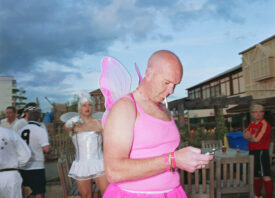Search this site
The Movie Set World of Real Life Cowboys


Karoliina Paatos’ project and book, American Cowboy, is full of things we recognise about the American West. Blue jeans, big skies, cowboy hats; they’re all there, colouring the series with their unmistakeable cinematic character. But in Paatos’ photos we are presented with a deeper view of this world, one that digs into its moments of quiet or domesticity, and so reminded that this lifestyle is not a series of cliches or visual tropes: it’s a life.
Paatos’ vision is gorgeous, with warm colours and breathtaking landscapes. It’s quirky, though, too: in one image a pair of jeans rest upright against the wall as rigid as a pair of scissors, starched so stiffly that they stand up alone; a cow having a tag punched through its ear looks at us goggle-eyed, its body nowhere to be seen. Paatos continues to lean into and away from the traditional view of the West, subverting expectations right after seeming to meet them totally. Animals (mainly horses, of course) and women, not usually foregrounded in portraits of the cowboy lifestyle, are portrayed with as much sensitivity as the men. In one, a sulky young girl has her hair brushed by her mother, gazing up at a wall of antler trophies. The minutiae of family drama still play out in a world that looks like a movie set.

What was your inspiration for the American Cowboy project?
I used to ride horses when I was a kid. Also, my parents were huge fans of the American West. I think I always wanted to find out if that world existed and finally seven years ago I had the chance to go see for myself.

How long did the project take, and what was your photographic process?
I started my project or one part of it almost seven years ago. I have had exhibitions and my book American Cowboy just came out but some parts of it will still continue for years. The images you see here are from different phases and parts of the project. Nowadays I am following two cowboy girls growing up in a remote cattle ranch in Nevada and my journey will continue alongside them into adulthood. Also my project with the gay rodeo is still ongoing. I use digital format and I like to use fixed lenses, mostly 50 mm. However on horseback my 70-200 mm lens is the most useful. My aim is to catch the feeling of the moment so I do post-processing to get there but as little as necessary. I use natural light and I’d rather capture the magical light in real life that try to create it afterwards. My method is to dwell and linger with my subjects so I can catch the essential moments and the spaces in between. I think the time spent always shows. I don’t plan my shots but doing a long term project you learn how things work and there’s repetition. Editing along the way helps with the focus too.

How did your subjects feel about the project, and your photographing them? Did you come to build relationships with them, and if so, did these relationships continue after the project ended?
I got lucky and met some good people in the very beginning and they introduced me to new good people. Of course it’s like any other relationship, you get as much as you’re willing to invest yourself. Later, it also helped when I could show what I had been doing. People liked my work and they wanted me to come follow their lives too. Whenever I am shooting on ranches I live with the people so some of them have become like a family to me. They have opened their homes, given their time, lent their saddles and horses to me. I am very grateful. I feel they really appreciate my interest in their culture and value what I am doing there. I think I would go visit them anyways, with or without my camera, but as I am a photographer I might as well bring it with me.

Is there a message you hope to convey with American Cowboy, or is it pure documentary?
I see my book American Cowboy more as a visual and emotional journey into a way of life that is not easy. I’m also showing there a more intimate and less seen side of a culture many of us think we know. It’s my interpretation, not a statement or truth. I would say my approach is definitely more on the poetic end of documentary. There are only two quotes in the book and they work more as images than as text. However they are real people so there is a title on every image in the end telling the time and place, names of people, sometimes even a little story but I didn’t want to put them next to the images.

What were your aesthetic inspirations for the series?
There are a lot of photographers whose style I admire but I would say it’s still more about the feeling of presence that I am after.

Why photography? What attracts you to the medium?
I used to draw all the time as a child and I thought that I want to become an artist but still have a career. Photography was never my passion until I ended up in the darkroom. Everything about it just felt right. I love how my camera gives me access to places I couldn’t go otherwise. I am endlessly curious about people and other ways to live and through photography I can visit all these parallel realities.





All images (C) Karoliina Paatos.


